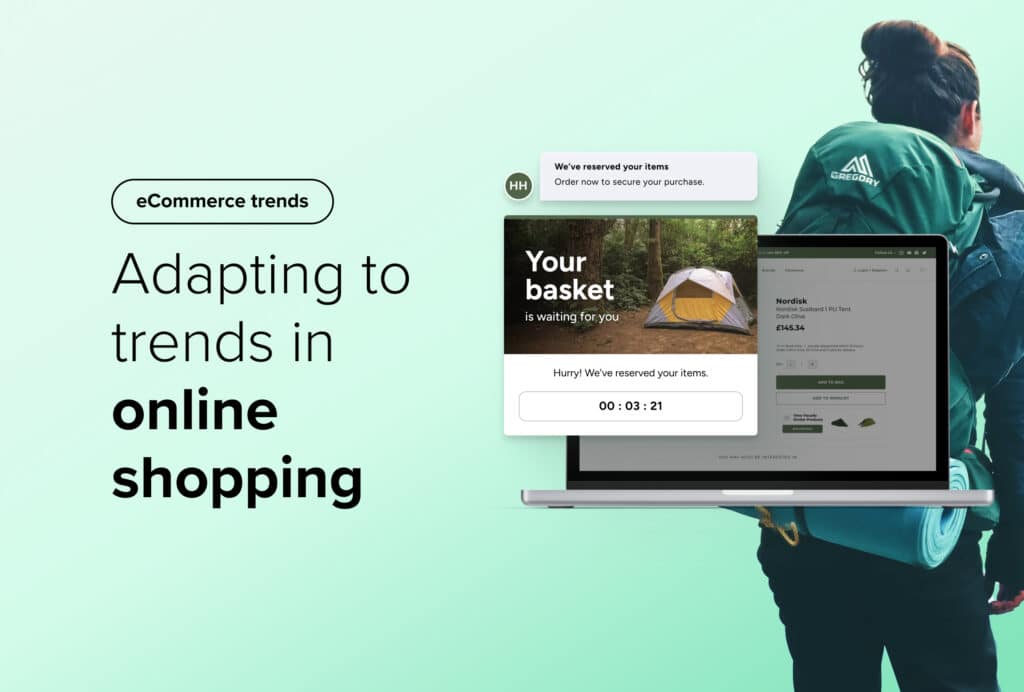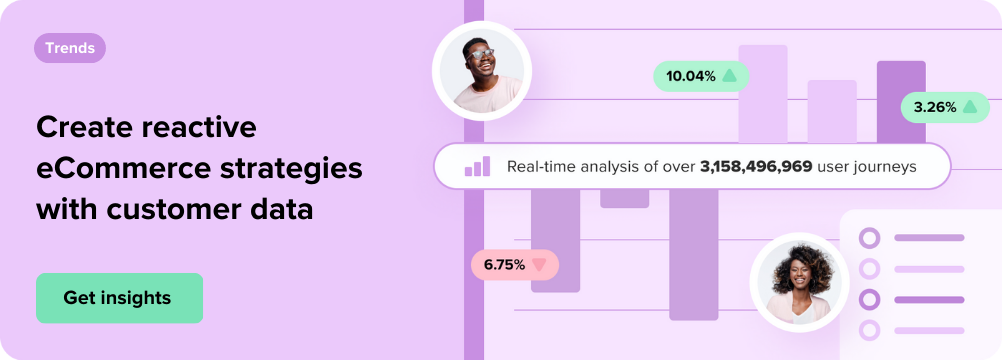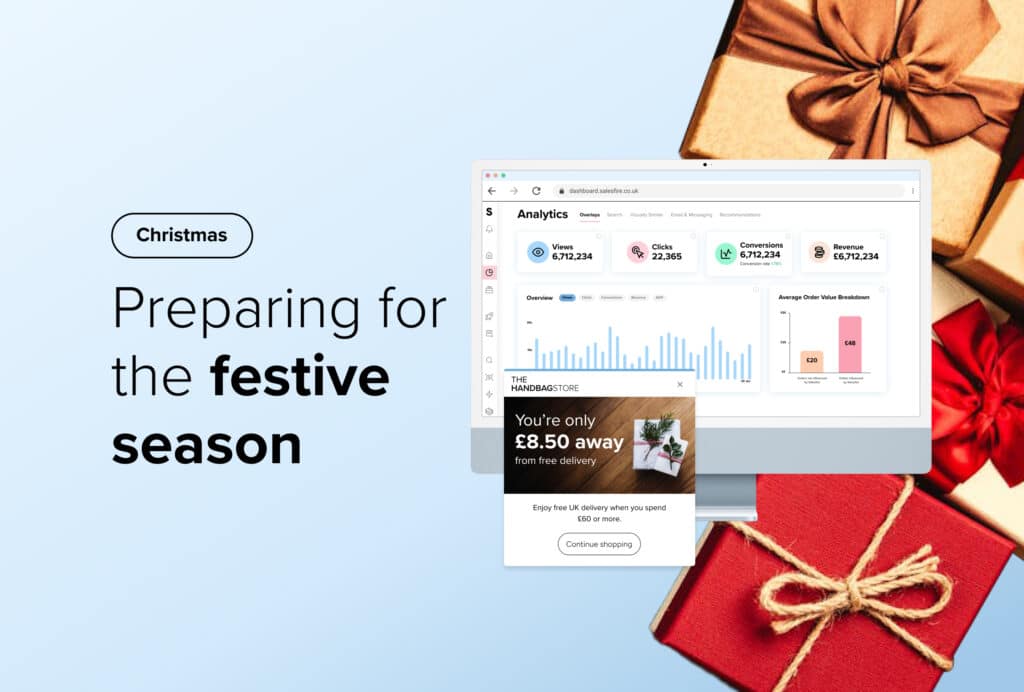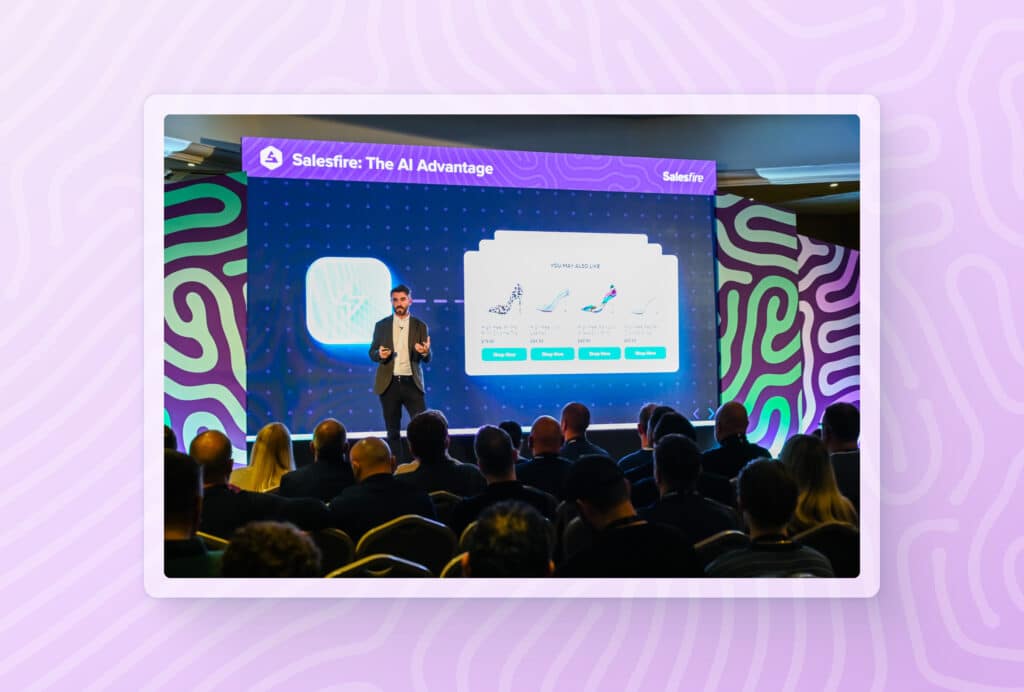How to Make Sense of Consumer Trends in Online Shopping | And How They Can Benefit Your Business
By Sophie Walker • Last updated: Thursday Jul 18th, 2024

Consumer behaviour is constantly evolving in response to societal and economic changes.
And online retailers are at the forefront of this changing landscape, with the global eCommerce market expected to reach $6.3 trillion in 2023.1
To cope with this shifting behaviour, online businesses should adapt their strategies and leverage trends to meet the needs of their customers.
In this article, we’ll discuss how monitoring consumer behaviour can benefit your business and outline the steps you can take to respond to changing eCommerce trends.
Suggested reading: Take a look at our report, ‘The State of eCommerce in 2022’, to learn more about the latest trends that are shaping eCommerce and how you can set your business apart from the competition.

The importance of consumer trends in online shopping
Where customers once found inspiration directly from their favourite brands, they are now met with a constant stream of products through social media and endless eCommerce storefronts.
As it becomes much harder to reach target audiences due to oversaturation in the eCommerce market, monitoring consumer trends through eCommerce data analytics is one way to ensure you stay ahead of the curve.
Carrianne Dukes, Senior Marketing Manager at eComOne, shared her knowledge of the current eCommerce climate:
‘Even though eCommerce is hugely saturated, there are still countless opportunities for ambitious brands that want to scale.
‘With consumer attention spans at an all-time low, businesses need to be smarter with their marketing efforts.’2
eCommerce trends can offer retailers crucial insights and present opportunities to create reactive strategies.
How trends can benefit your eCommerce site
As eCommerce sites take the steps to respond to changes in the industry, having a comprehensive understanding of the current state of consumer trends can help online retailers:
- Understand what their customers want
- Benchmark their performance against industry competitors
- Find opportunities to enhance customer experiences through optimisation
- Create reactive and relevant strategies
Adapting to meet the new consumer needs is essential for eCommerce success in such a competitive landscape, but online retailers need to ensure this is not done at the expense of their brand identity and, subsequently, customer retention.
Online retailers should be selective in the trends they adopt, ensuring they fit with their core values and messaging.
Pro tip: Read our article, ‘The 2023 eCommerce Trends You Need to Look Out For’, to discover the biggest current trends in eCommerce.
How to monitor and adapt to consumer trends
It can be challenging to work out which eCommerce trends your business should capitalise on or even how to identify buying patterns in the first place.
Let’s dive into some of the ways you can monitor consumer behaviour and adapt your business to reflect the trends that are shaping the eCommerce industry.
1. Track consumer behaviour with Salesfire Trends
As we start to make sense of how eCommerce trends can impact shoppers’ expectations, we can begin to understand how this affects online sales.
Through an eCommerce data platform like Salesfire Trends, you can identify patterns in consumer behaviour across the whole sales funnel. These insights can then inform your marketing strategies and help you to make better business decisions based on buyers’ behaviour.
Salesfire Trends tracks a wide range of customer data, monitoring key performance indicators and offering valuable insights into the state of eCommerce. The Trends tool provides eCommerce industry data on:
- Site visitors
- Pageviews
- Orders
- Revenue
- Conversion rates
- AOV
Retailers can use this data to track industry revenue and benchmark their own performance against competitors, enabling them to understand if changes in consumer behaviour are positively or negatively affecting profit margins.
Joe Turner, Director at Proof3, offered some insight into the importance of using big data in eCommerce to track trends:
‘The good news is that there’s a wealth of accessible data already out there that forecast and track industry trends (a respectful nod to Salesfire Trends), which, when blended with your own first-party customer data can be used to create much more accurate audience targeting.’3
Monitoring and analysing industry data provides retailers insight into how consumers are preferring to spend their money and the impact trends are having on specific product categories.
2. Make sense of social media trends
There is no doubt that social media platforms have a direct impact on eCommerce.
The average global online shopping order value that came from social media platforms reached 86 billion U.S. dollars in the second quarter of 2022.4
Social media strategies are crucial for brands looking to increase brand awareness, find new ways to reach their target audience and generate organic social proof.
As we welcome a new generation of digitally connected shoppers, 97% of Gen Z consumers say they now use social media as their top source of shopping inspiration.5
We can also see the impact that trending or viral products have on online shopping trends.
A recent example of this is a pair of Sony headphones that went viral on TikTok and Instagram and then became a hard-to-get item.
Retailers can use the Trends platform to gain insight into how certain categories see spikes in conjunction with items such as this becoming popular on social media.
As new viral products and social media trends pop up each day, brands can leverage this in order to boost their own revenue. They can also use the data they collect to power their own eCommerce social media strategy by:
- Conducting market research on viral products: By monitoring viral products and social media trends you gain crucial insights into buyer behaviour and consumer shopping habits. You can then look for similar products in your catalogue that you could promote to shoppers on the back of these viral trends.
- Promoting popular items: Through AI-driven Recommendations units, you could push your most popular products or services that may be the most relevant to your tech-savvy shoppers.
- Leveraging social commerce: Showcase your products where your shoppers are browsing. Using social commerce, you can empower users to discover your products through social media platforms.
- Integrating Visual Search: Whether it be a screenshot from social media or a quick snap taken on a mobile device, online retailers can seamlessly deliver the products that users want to find using Visual Search. This streamlined search option allows for effortless browsing and on-the-go mobile shopping.
The growing social media market
The latest statistics show that there are an estimated 4.89 billion social media users worldwide in 2023, a 6.5% increase from 2022.6
As social media usage grows, it can provide an opportunity to identify purchase intent among shoppers and drive eCommerce strategy.
Carrianne from eComOne spoke further on the importance of taking notice of the data collected on social media:
‘In a world of five-second trends, it’s essential that brands identify ones that their customers actually care about. See what your followers are engaging with on social media, do a survey, conduct a focus group, use Google Trends, and use your own data to dig deeper.’7
Suggested reading: Read more about the social product discovery experience in our blog, ‘How Has Social Media Influenced the eCommerce Product Discovery Experience?’.
3. Utilise Personalisation
Personalisation in eCommerce isn’t going anywhere anytime soon, with 76% of consumers saying they feel frustrated when on-site content isn’t personalised for them.8
After all, each online shopper’s journey is unique and retailers that take a one-size-fits-all approach may be missing out on valuable conversions.
eCommerce giants such as Amazon and eBay have already invested heavily in personalisation solutions, meaning modern eCommerce shoppers have come to expect tailored experiences and personalised customer service as standard. As one of the most relevant trends in eCommerce, a personalised shopping experience can:
- Help your customer feel understood by your brand
- Streamline the shopping experience
- Encourage a sense of brand loyalty and improve customer satisfaction
Personalising your site based on consumer trends
Joe Turner from Proof3 gave further insight on the ways retailers can make use of personalisation in their on-site strategy:
‘Retailers should also be leveraging the power of AI solutions to create hyper-personalised content that engages the customer and enhances the shopping experience.
“Think dynamic product recommendations, targeted messaging based on customer behaviour and AI-powered search.’9
Website personalisation solutions work to maximise conversions and seamlessly influence online sales. Some examples of tools you could integrate into your site include:
- Overlays: Trigger targeted messaging based on customer behaviour and trends to offer an incentive at exactly the right time, remind users of your free delivery threshold or encourage shoppers to complete their order.
- Recommendations: Make online product discovery seamless with personalised product matches. AI handpicks items based on shopper data and connects users with their ideal online purchases, optimising product discovery and increasing AOV.
Internet users are faced with an overwhelming amount of options when shopping on eCommerce sites, and will want to feel that brands know their tastes, can anticipate their needs, and remember them from previous sessions.
As personalisation becomes more prevalent, retailers are leveraging the latest technologies and AI to create a more efficient, tailored on-site journey for their shoppers to enhance the user experience.
Pro tip: Take a look at our webinar, ‘How to Get eCommerce Personalisation Right’, for more ideas on how to maintain a competitive edge through personalisation.
4. Retain your brand identity
The importance of branding and positioning is growing as it becomes increasingly difficult to establish your own brand identity in a competitive eCommerce marketplace.
As we move away from traditional brick-and-mortar stores and make the switch to eCommerce, growing your core branding and adopting brand values can help you stand out from your competitors. This means:
- Creating consistency throughout all platforms, social channels, landing pages, and, of course, your eCommerce site.
- Encouraging the feeling of unique brand identity through impactful visuals and trends-focused marketing.
- Establishing brand values that you feel reflect who you are as a business.
Carrianne from eComOne said:
‘Having a mix of planned activity and reactivity for trends is key for success. For example, in the fashion world, body positivity and sustainability are two trends that are here to stay for some time. Therefore, fashion brands can plan their marketing campaigns around this.
‘It’s also never a good idea to sacrifice your brand values in the hope of going viral or seeming relevant.’10
Achieving a balance between online trends and brand individuality
Taking the steps to optimise your website using Digital Assistant, you can capitalise on trends while maintaining consistent branding to create a more streamlined user experience from the moment your shopper first interacts with your site. You can use Digital Assistant to ensure your brand is recognisable by:
- Customising on-site widgets: You can incorporate your brand colours, imagery, and logo into your Digital Assistant and ensure the visuals of your website are consistent.
- Utilising ‘Traffic Source’ condition: Identify the source of your traffic, such as those coming from paid ad links or specific landing pages, to display content that is relevant and aesthetically similar.
- Displaying your USP with an Overlay: Communicate your brand values in the form of a USP Overlay. For example, if your brand has sustainability at its core, ensure that you showcase this on-site through targeted messages to appeal to like-minded shoppers.
When optimising the on-site experience in response to consumer trends, it’s crucial to consider the complete customer journey, how it’s been designed, and address if there is consistency across the board when communicating your core values and messaging.
Capitalising on consumer trends can boost eCommerce success
As retailers navigate through a competitive eCommerce landscape, it’s essential to make the most of critical eCommerce trends to generate profit and encourage loyal customers. Taking notice of fluctuations within the industry can allow you to build a firm understanding of what is driving consumer behaviour.
By optimising your website, making use of the latest AI technologies, and keeping an eye on shopper behaviour with data platforms like Trends, you can create strategies that respond to the needs of modern consumers, and help you get ahead of the competition.

1 38 eCommerce Statistics of 2023 – Forbes advisor
2 eComOne
3 Proof3
4 Social media advertising and marketing worldwide – statistics & facts | Statista
5 Gen Z And The Rise Of Social Commerce – Forbes
6 How Many People Use Social Media in 2023 – Oberlo
7 eComOne
8 The value of getting personalization right—or wrong—is multiplying | McKinsey
9 Proof3
10 eComOne
See how Salesfire can help you optimise your product discovery experience, email one of our experts at [email protected] or book a free demo of our personalisation tools.



